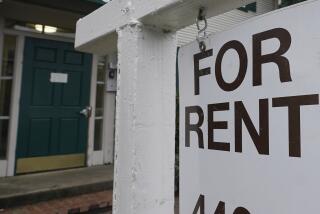HUD Raises Housing Subsidy to Match Rising Rents
- Share via
Low-income residents of Orange County, San Diego and dozens of other U.S. communities will receive higher federal housing subsidies to help keep pace with skyrocketing housing costs, the Department of Housing and Urban Development announced Tuesday.
Los Angeles County, whose high-rent areas already have benefited from higher rent subsidies, was not included in the first round of cities receiving additional federal assistance but may still qualify based on a second set of criteria.
The hike in subsidies came in response to the growing housing crisis among low-income families, whose rents in some markets have risen twice as fast as the pace of inflation, according to HUD statistics.
HUD officials hope the new measure will make an additional 1.4 million apartments available to low-income families in areas where fast-rising prices are shutting them out of the rental market and pushing them farther from where they work.
“This announcement is very good news,” said Irvine City Councilman Larry Agran. “At a time when we’re struggling to meet our commitment to provide a full range of housing opportunities so that people can live and work in Orange County, any additional federal, state or local resources are welcome.”
Orange County currently has about 16,000 rental units that qualify as voucher housing under HUD guidelines. That number will increase to 20,500 units after Tuesday’s announcement, a HUD spokesman said.
The Section 8 Housing Choice voucher program is the largest of HUD’s three programs that help low-income families find affordable housing. Under the program, voucher holders pay no more than 30% of their income toward rent. The federal government pays the balance.
The Orange County “fair market rent”--the estimate of monthly rental housing costs that HUD uses to determine subsidy levels--is $990. Under the new proposal, that value will rise to $1,046, which will give families a greater choice of where they live and how much they spend on rent, said John Hambuch, an Orange County housing authority manager.
“We’ve been finding out that one in three families is having to give their vouchers back after four months because they can’t find housing that falls under HUD’s guidelines,” Hambuch said. “This announcement raises the bar. It will make a difference.”
Although Tuesday’s announcement increases their chances of finding units, landlords in a tight rental market still may not take the vouchers.
“That problem doesn’t go away. We have to rely on landlords who are satisfied with the program,” Hambuch said.
HUD named 450 communities nationwide that qualified for the increased subsidies, based on the criteria that voucher holders in those communities are concentrated in a limited number of neighborhoods, and affordable housing is not widely available in those metropolitan areas.
Additional cities, including Los Angeles, may be added to the list after they provide data proving that more than a quarter of the families issued vouchers cannot find housing during a six-month period.
The Federal Home Loan Bank of San Francisco also announced Tuesday it will purchase $102 million in mortgage bonds from the California Housing Finance Agency to boost affordable housing in the state.
“It’s ironic that the Southern California economy is doing so well and people are doing so well, that it has driven up prices and made housing less affordable,” said Alex Sachs, a Southern California HUD spokesman. “The announcement by HUD should enable low-income folks in high-cost Southern California areas to have a better chance at finding safe, decent, affordable housing.”
*
Times staff writer Jennifer Mena contributed to this report.
More to Read
Sign up for Essential California
The most important California stories and recommendations in your inbox every morning.
You may occasionally receive promotional content from the Los Angeles Times.










